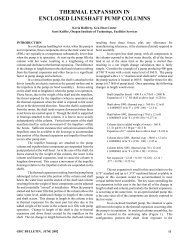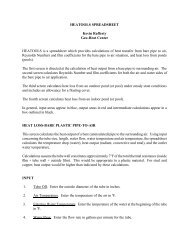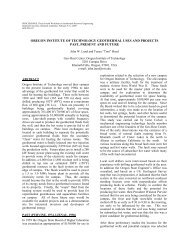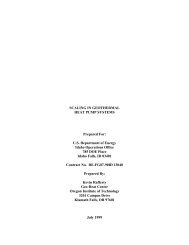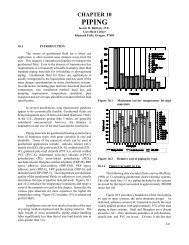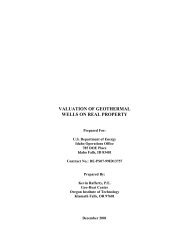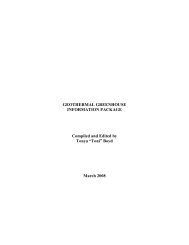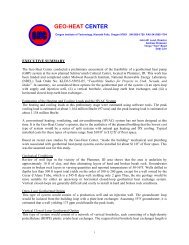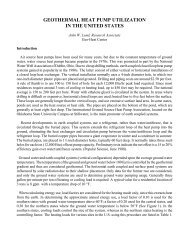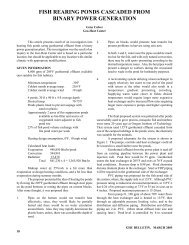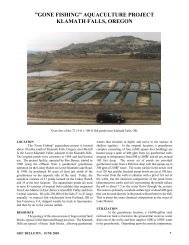Aquaculture, Chapter 15 Geothermal Direct Use ... - Geo-Heat Center
Aquaculture, Chapter 15 Geothermal Direct Use ... - Geo-Heat Center
Aquaculture, Chapter 15 Geothermal Direct Use ... - Geo-Heat Center
You also want an ePaper? Increase the reach of your titles
YUMPU automatically turns print PDFs into web optimized ePapers that Google loves.
<strong>15</strong>.1 INTRODUCTION<br />
One of the most common areas of interest in<br />
geothermal direct use is that of aquaculture. For those<br />
involved with the initial planning of such a project, one of<br />
the first questions to be addressed relates to project size.<br />
In most geothermal applications, the maximum pond area<br />
that can be developed is restricted by the maximum heat<br />
available from the resource. It is the purpose of this<br />
chapter to present a brief introduction to the subject of<br />
heat loss from ponds (or pools) so that developers can<br />
make an informed evaluation of geothermal resources for<br />
this purpose.<br />
<strong>15</strong>.2 TEMPERATURE REQUIREMENTS FOR<br />
SELECTED SPECIES<br />
In order to determine the heat loss of the ponds, it<br />
is necessary to first select the temperature at which the<br />
water must be maintained. Table <strong>15</strong>.1 provides a<br />
summary of appropriate temperatures for selected species.<br />
In addition, growth periods for cultures at optimum<br />
temperatures are shown in the last column.<br />
CHAPTER <strong>15</strong><br />
AQUACULTURE<br />
Kevin D. Rafferty, P.E.<br />
<strong>Geo</strong>-<strong>Heat</strong> <strong>Center</strong><br />
Klamath Falls, OR 97601<br />
<strong>15</strong>.3 HEAT EXCHANGE PROCESSES<br />
A non-covered body of water, exposed to the<br />
elements, exchanges heat with the atmosphere by way of<br />
four mechanisms: (a) evaporation, (b) convection, (c)<br />
radiation, and (d) conduction. Each of these is influenced<br />
by different parameters that are discussed separately in<br />
the following paragraphs.<br />
<strong>15</strong>.3.1 Evaporative Loss<br />
Evaporation is generally the largest component of<br />
the total heat loss from the pond. Considering<br />
evaporation, the loss of volume generally comes to mind<br />
rather than the loss of heat. However, in order to boil<br />
water (and hence cause evaporation) heat must be added.<br />
The quantity of heat required to evaporate one pound of<br />
water varies with temperature and pressure, but under<br />
normal atmospheric conditions the value is approximately<br />
1,000 British thermal units (Btu). When water is<br />
evaporated from the surface of the pond, the heat is taken<br />
from the remaining water. As a result, as each pound of<br />
water evaporates from the surface, approximately 1,000<br />
Btu are lost with escaping vapor.<br />
Table <strong>15</strong>.1 Temperature Requirements and Growth Periods for Selected <strong>Aquaculture</strong> Species a<br />
________________________________________________________________________________________________<br />
Tolerable Optimum Growth Period<br />
Species Extremes ( o F) Growth ( o F) to Market Size (mos)<br />
Oysters 32 to 97 typ 76 to 78 typ 24<br />
Lobsters 32 to 88 72 to 75 24<br />
Penaeid Shrimp<br />
Kuruma 40 to ? 77 to 87 6 to 8 typ<br />
Pink 52 to 104 75 to 85 6 to 8<br />
Salmon (Pacific) 40 to 77 59 6 to 12<br />
Freshwater Prawns 75 to 90 83 to 87 6 to 12<br />
Catfish 35 to 95 82 to 87 6<br />
Eels 32 to 97 73 to 86 12 to 24<br />
Tilapia 47 to 106 72 to 86 --<br />
Carp 40 to 100 68 to 90 --<br />
Trout 32 to 89 63 6 to 8<br />
Yellow Perch 32 to 86 72 to 82 10<br />
Striped Bass ? to 86 61 to 66 6 to 8<br />
__________________<br />
a. Behrends, 1978<br />
________________________________________________________________________________________________<br />
327
Losses can occur by evaporation even when the<br />
water temperature is at or below the surrounding air<br />
temperature.<br />
The rate at which evaporation occurs is a function<br />
of air velocity and the pressure difference between the<br />
pond water and the water vapor in the air (vapor pressure<br />
difference). As the temperature of the pond water is<br />
increased or the relative humidity of the air is decreased,<br />
evaporation rate increases. The equation that describes<br />
the rate of evaporation is (ASHRAE, 1995).<br />
where<br />
Wp = (0.097 + 0.038v) · (Pw - Pa) · A<br />
Wp = rate of evaporation (lbm/h)<br />
A = pond surface area (ft 2 )<br />
v = air velocity, (mph)<br />
Pw = saturation vapor pressure of the pond water<br />
(psia)<br />
Pa = saturation pressure at the air dew point (psia)<br />
For enclosed ponds or indoor swimming pools, this<br />
equation can be reduced to (ASHRAE, 1995).<br />
where<br />
Wp = 0.204 · A · (Pw - Pa)<br />
Wp = rate of evaporation (lbm/h)<br />
A = pond area (ft 2 )<br />
Pw = saturation pressure of the pond water (psia)<br />
Pa = saturation pressure at air dew point (psia)<br />
Following are some common values for Pw and Pa:<br />
For Pw: @ 60 o F water, Pw = 0.256 psia<br />
@ 70 o F water, Pw = 0.363 psia<br />
@ 80 o F water, Pw = 0.507 psia<br />
@ 90 o F water, Pw = 0.698 psia<br />
For Pa: For outdoor locations with a design dry<br />
bulb air temperature below 30 o F, Pa can<br />
be taken as 0.074 psia.<br />
For indoor locations with a design of<br />
approximately 75 o F and 50% relative humidity, Pa<br />
can be taken as 0.211 psia.<br />
For example, assume a pond with a surface area of<br />
500 ft 2 (10 ft x 50 ft) located outside in an area with<br />
design temperature of <strong>15</strong> o F. Wind velocity is 5 mph and<br />
pond water is to be 80 o F.<br />
Wp = (0.097 + (0.038 · 5)) · (.507 - .074) · 500<br />
= 62.1 lb/hr<br />
To obtain the heat loss (q EV) in Btu/h, simply<br />
multiply the lbm/h loss by the value of 1,050 Btu/lbm.<br />
328<br />
q EV = 62.1 lb/h · 1,050 Btu/lb<br />
q EV = 65,200 Btu/h<br />
This is the peak or design heat loss. It is important<br />
to note that the example values given above are for the<br />
design (worst) case. At higher outdoor air temperatures<br />
and different relative humidities, this value would be less.<br />
As mentioned earlier, the rate of evaporation loss is<br />
influenced by the vapor pressure difference between the<br />
pond water and the water vapor in the air. Reduced water<br />
temperature would reduce the vapor pressure differences<br />
and hence, the rate of evaporation.<br />
Wind speed over the surface of the water has a very<br />
substantial impact upon both evaporative and convective<br />
heat losses from ponds. When calculating the design heat<br />
loss for ponds, it is not necessary to use unrealistically<br />
high wind speeds. In general, the coldest outdoor<br />
temperatures are not accompanied by high wind speed<br />
conditions.<br />
In addition, sustained high wind conditions are<br />
generally not experienced for extended periods of time.<br />
This, coupled with the high thermal mass of the water,<br />
allows the pond or pool to sustain brief high wind periods<br />
without significant water temperature drop.<br />
Mean wind speeds which appear in <strong>Chapter</strong> 1 of<br />
the Department of Defense publication Engineering<br />
Weather Data (AFM 88-29)(1978) are appropriate values<br />
for these calculations.<br />
Pond surface area can be influenced by surface<br />
disturbances due to waves or the use of splash-type<br />
aeration devices. The calculation presented above are<br />
based upon a calm water surface. If surface disturbances<br />
exist, the pond surface area (“A” in the above equation)<br />
should be increased to reflect the departure from the calm<br />
water condition.<br />
<strong>15</strong>.3.2 Convective Loss<br />
The next major mechanism of loss from the pond<br />
surface is that of convection. This is the mode associated<br />
with the heat loss caused by cold air passing over the<br />
pond surface. The two most important influences on the<br />
magnitude of convective heat loss are wind velocity and<br />
temperature difference between the pond surface and the<br />
air. This is evidenced in (Wolf, 1983):<br />
where<br />
q CV = (0.198v) · A · (Tw - Ta)<br />
q CV = convection heat loss (Btu/h)<br />
v = air velocity (mph)<br />
A = pond area (ft 2 )<br />
Tw = water temperature ( o F)<br />
Ta = air temperature ( o F)
The shape of the pond and the direction of the<br />
prevailing wind influences the magnitude of the<br />
convective heat loss. The method used here is<br />
appropriate for pond dimensions of up to approximately<br />
100 ft . For very large ponds, convective losses would be<br />
up to 25% less than the figure which result from this<br />
method.<br />
For an indoor pool, this equation would be (Lauer,<br />
undated):<br />
q CV = 0.38 (Tw - Ta) 0.25 · A · (Tw -Ta)<br />
Using the example from above (<strong>15</strong> o F design<br />
temperature, 80 o F water and 5 mph wind), the following<br />
convective heat loss can be calculated:<br />
q CV = (0.198v · 5 ft/s) · 500 ft 2 · (80 o - <strong>15</strong> o )<br />
q CV = 32,200 Btu/h<br />
16.3.3 Radiant Loss<br />
Radiant heat loss, the third largest component of<br />
the total heat loss is dependent primarily on the<br />
temperature difference between the pond surface<br />
temperature and the surrounding air temperature. Under<br />
normal circumstances, radiant heat exchange is assumed<br />
to occur between solid bodies with little or no gain to the<br />
air in between the bodies. However, because of the<br />
evaporative losses near the pond surface, the air tends to<br />
contain a large quantity of water vapor. When this is the<br />
case, the pond surface radiates to the water vapor in the<br />
air, which is assumed to be at the temperature of the air<br />
itself. The equation describing this process is (Stoever,<br />
1941):<br />
where<br />
q RD = 0.174 · 10 -8 · 0.93 [(460 + Tw) 4<br />
- (460 + Ta) 4 ] · A<br />
q RD = radiant heat loss (Btu/h)<br />
Tw = pond water temperature ( o F)<br />
Ta = air temperature ( o F)<br />
A = pond surface area (ft 2 )<br />
Again referring to the above example (<strong>15</strong> o F design<br />
temperature, 80 o F pond temperature), the following<br />
radiant heat loss is calculated:<br />
q RD = 0.174 · 10 -8 · 0.93 [(460 + 80 o F) 4<br />
- (460 + <strong>15</strong>) 4 ] · 500<br />
q RD = 27,600 Btu/h<br />
<strong>15</strong>.3.4 Conductive Loss<br />
The final mode of heat loss is that of conduction.<br />
This is the loss associated with the walls of the pond. Of<br />
the four losses, conduction is by far the smallest and in<br />
many calculations is simply omitted. The following<br />
method (ASHRAE, 1985) is valid for a pond depth of 3<br />
to 5 ft.<br />
q cd = {[(L + W)· 2] +(L · W · 0.02)}[(Tw - (Ta + <strong>15</strong>)]<br />
where<br />
q CD = conductive heat loss (Btu/h)<br />
L = length of pond (ft)<br />
W = width of pond (ft)<br />
Tw = design water temperature ( o F)<br />
Ta = design outside air temperature ( o F)<br />
This calculation assumes the use of lined pond<br />
construction. That is, there is no significant leakage of<br />
water from the walls or floor of the pond.<br />
Using the previous example, the following<br />
conductive heat loss is calculated:<br />
q CD = {[(10 + 50) · 2] + ( 10 · 50 · 0.02)} [80 - (<strong>15</strong> + <strong>15</strong>)]<br />
q CD = 6,500 Btu/h<br />
Table <strong>15</strong>.2 summarizes the results of the<br />
calculations performed for the example 500 ft 2 pond.<br />
Table <strong>15</strong>.2 Summary of Example <strong>Heat</strong> Loss<br />
______________________________________________<br />
<strong>Heat</strong> Loss Method Loss (Btu/h)<br />
Amount (%)<br />
Evaporation 65,200<br />
50<br />
Convection 32,200 24<br />
Radiation 27,600 21<br />
Conduction 6,500 5<br />
TOTAL 131,500 100<br />
______________________________________________<br />
These losses are the peak or maximum heat loss.<br />
At any given time during the year, other than the design<br />
case, the heat loss would be less than this value. The<br />
annual heating requirement cannot be determined from<br />
simply multiplying the peak heating requirement by 8760<br />
h/y. Because of the need for consideration of varying<br />
temperature, wind, humidity, and solar heat gain, methods<br />
for calculating the annual heating requirement are beyond<br />
the scope of this chapter.<br />
329
<strong>15</strong>.4 SURFACE COVER<br />
<strong>Heat</strong> losses from the pond surface are most heavily<br />
influenced by wind velocity and the temperature<br />
difference between the pond and the surrounding air.<br />
Any method that can be employed to reduce these values<br />
can substantially reduce heating requirements.<br />
For outdoor pools, a floating cover is an excellent<br />
example. The use of a 0.5 in. floating foam cover (on the<br />
pool surface) would reduce the peak heat loss for the<br />
example pool to the values shown in Table <strong>15</strong>.3.<br />
Table <strong>15</strong>.3 Summary of Example <strong>Heat</strong> Loss Using<br />
Pool Cover<br />
______________________________________________<br />
<strong>Heat</strong> Loss Method Loss (Btu/h)<br />
Amount (%)<br />
Evaporation 0<br />
0<br />
Convection 5,200 35<br />
Radiation 3,200 22<br />
Conduction 6,500 43<br />
TOTAL 14,900 100<br />
______________________________________________<br />
This peak load is only approximately 11% of the<br />
originally calculated heat loss. This is, in large measure,<br />
a result of the elimination of evaporation loss that is<br />
provided by a floating type cover. Unfortunately, a<br />
floating cover is generally not considered practical for<br />
commercial aquaculture applications.<br />
<strong>15</strong>.5 POND ENCLOSURE<br />
A pond enclosure is another (though much more<br />
expensive) option for reducing heat loss. The advantages<br />
provided by an enclosure depend to a large extent upon<br />
the construction techniques employed (covering material,<br />
degree of enclosure, presence, or absence of ventilation.<br />
The variety of construction methods and materials<br />
available are too numerous to cover here. The basic<br />
advantages of an enclosure are: (a) reduced air velocity,<br />
(b) reduced temperature difference between the pond and<br />
surrounding air, and (c) reduced vapor pressure<br />
difference between the pond water and air (increased<br />
relative humidity). These effects reduce the losses<br />
associated with evaporation, convection and radiation.<br />
Assuming an enclosure is placed over our example<br />
pond, reducing air velocity to the 10 to 30 ft/min range,<br />
increasing humidity to 90% and air temperature to 48 o F<br />
(half way between outside air and pond water<br />
temperature), pond heat loss would be reduced to the<br />
values shown in Table <strong>15</strong>.4.<br />
330<br />
Table <strong>15</strong>.4 Summary of Example <strong>Heat</strong> Loss Using<br />
Pond Enclosure<br />
______________________________________________<br />
<strong>Heat</strong> Loss Method Loss (Btu/h)<br />
Amount (%)<br />
Evaporation 35,200<br />
47<br />
Convection 14,500 19<br />
Radiation 18,200 25<br />
Conduction 6,500 9<br />
TOTAL 74,400 100<br />
______________________________________________<br />
This value amounts to 57% of the original example.<br />
It is often erroneously believed that the use of a<br />
pond enclosure will allow the air within to become<br />
saturated and thus, eliminate evaporative loss from the<br />
pond surface. This is not the case in most applications.<br />
For greenhouse-type enclosures (the most common), the<br />
inside surface tempera-ture of the roof and walls is well<br />
below the dew point of the air during the winter. This<br />
results in substantial condensa-tion occurring on these<br />
surfaces. As a result, moisture is continuously removed<br />
from the air allowing more to be absorbed (through<br />
evaporation) from the pond surface.<br />
For conventional constructed buildings, ventilation<br />
air is normally supplied to reduce humidity in the space to<br />
a point which will protect the structure from moisture<br />
damage. Under these conditions of course, evaporation<br />
continues to occur and an additional heating load is<br />
imposed by the requirement to heat the ventilation air.<br />
This topic is covered in detail in <strong>Chapter</strong> 4 of the 1995<br />
ASHRAE Handbook of Applications.<br />
<strong>15</strong>.6 THERMAL MASS<br />
One final method for reducing peak heating<br />
requirements for pond or pool heating lies in the use of<br />
the large thermal mass supplied by the water itself. Water<br />
is an excellent heat storage medium. Assuming the<br />
example pond is 5 ft deep and 500 ft 2 in area, the total<br />
volume con-tained would be 2,500 ft 3 . At 7.49 gal/ft 3 ,<br />
this results in 18,725 gal or <strong>15</strong>6,000 lbm of water at 8.33<br />
lbm/gal. Be-cause 1 lb of water gives up one Btu for each<br />
degree it is cooled, this means that our example pond that<br />
contains <strong>15</strong>6,000 lbm of water could provide <strong>15</strong>6,000 Btu<br />
of offset heating requirements if it were allowed to cool<br />
1 o F. This stored heating capacity can be used to reduce<br />
the peak heating requirement on the heating system.<br />
Using the originally calculated peak heating requirement<br />
of 131,500 Btu/h, an example of thermal storage use<br />
follows. Assume that the peak heating requirement<br />
occurs over an 8-hour period after which, because of air<br />
temperature increase and solar gain, the heating load is<br />
reduced. Further, assume that the heating system is
designed to supply only 80% of the peak requirement.<br />
What will happen to the pond temperature?<br />
First, calculate the total heat required for the 8-hr<br />
period.<br />
8 h · 131,500 Btu/h = 1,052,000 Btu<br />
Second, calculate the heat that the system can<br />
supply based on its 80% capacity.<br />
8 h · (0.80 · 131,500 Btu/h) = 842,000 Btu<br />
Then, calculate the difference to be supplied by<br />
allowing the pond water to cool.<br />
1,052,000 Btu - 842,000 Btu = 210,400 Btu<br />
Finally, calculate the drop in pond temperature<br />
caused by supplying the heat required.<br />
210,400 Btu/(<strong>15</strong>6,000 lbm · 1 Btu/lbm o F) = 1.35 o F.<br />
As a result, the pond will have cooled by 1.35 o F.<br />
The heating system would then bring the pond back up to<br />
the temperature during the day when higher temperatures<br />
and solar gain would reduce heating requirements.<br />
An alternate way of looking at this is in terms of<br />
the selection of the ambient temperature to be used in the<br />
calculation of the pond losses. <strong>Use</strong> of the mean-duty<br />
temperature in-stead of the minimum-duty temperature<br />
would allow the design to incorporate the effect of the<br />
pond thermal mass on the heat loss. <strong>Use</strong> of an air<br />
temperature higher than the mean-duty value could be<br />
employed in very clear climates where solar heat gain can<br />
be assumed to contribute to pond heating during the day.<br />
The degree to which thermal storage can be<br />
incorpo-rated into the heating system design is a complex<br />
issue of environmental factors, pond characteristics, and<br />
the species being raised. Some species, such as prawns,<br />
are particu-larly sensitive to temperature fluctuations<br />
(Johnson, 1978).<br />
<strong>15</strong>.7 FLOW REQUIREMENTS<br />
The rate of flow required to meet the peak heating<br />
demand of a particular pond is a function of the<br />
temperature difference between the pond water and the<br />
resource temperature. The following equation can be<br />
used to determine the flow (Q) requirement and is<br />
written:<br />
where<br />
Q = q tot/[500 · (Tr - Tw)]<br />
Q = resource flow requirement (gpm)<br />
q tot = total calculated pond heat loss<br />
= q EV + q CV + q RD + q CD<br />
Tw = pond temperature ( o F)<br />
Tr = resource temperature ( o F)<br />
500 = constant (Btu/h gpm o F)<br />
Assuming that our example pond is to be heated<br />
with a resource temperature of 100 o F:<br />
Q = 105,120 Btu/h/[500 · (100 o F - 80 o F)]<br />
Q = 10.5 gpm<br />
Again, the point is made that this is the peak<br />
requirement. The required flow at any other time would<br />
be a value
REFERENCE<br />
American Society of <strong>Heat</strong>ing, Refrigeration and Air<br />
Conditioning Engineers, 1995. "Handbook of<br />
Applications, ASHRAE, Atlanta, GA.<br />
American Society of <strong>Heat</strong>ing, Refrigeration and Air<br />
Conditioning Engineers, 1985. "Handbook of<br />
Fundamentals", ASHRAE, Atlanta, GA, pp. 25.6.<br />
Behrends, L. L., 1978. "Waste <strong>Heat</strong> Utilization for Agriculture<br />
and <strong>Aquaculture</strong>", Tennessee Valley<br />
Authority.<br />
Department of Defense, 1978. “Engineering Weather<br />
Data,” AFM 88-29, TM 5-785, NAUFAC, pp.. 89,<br />
Washington, DC.<br />
332<br />
Johnson, W. C., 1978. "Culture of Freshwater Prawns<br />
Using <strong><strong>Geo</strong>thermal</strong> Waste Water", <strong>Geo</strong>-<strong>Heat</strong><br />
<strong>Center</strong>, Klamath Falls, OR.<br />
Lauer, B. E., undated. "<strong>Heat</strong> Transfer Calculations,"<br />
Handbook reprinted from the Oil and Gas Journal,<br />
pp.. 9.<br />
Stoever, H. J., 1941. "Applied <strong>Heat</strong> Transmission,"<br />
McGraw-Hill, New York, NY.<br />
Wolf, H., 1983. "<strong>Heat</strong> Transfer", Harder & Row, New<br />
York, NY, pp.. 254.



